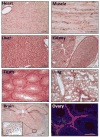Efficient, specific, developmentally appropriate cre-mediated recombination in anterior pituitary gonadotropes and thyrotropes
- PMID: 23996951
- PMCID: PMC4007265
- DOI: 10.1002/dvg.22425
Efficient, specific, developmentally appropriate cre-mediated recombination in anterior pituitary gonadotropes and thyrotropes
Abstract
Tissue-specific expression of cre recombinase is a well-established genetic tool to analyze gene function, and it is limited only by the efficiency and specificity of available cre mouse strains. Here, we report the generation of a transgenic line containing a cre cassette with codon usage optimized for mammalian cells (iCre) under the control of a mouse glycoprotein hormone α-subunit (αGSU) regulatory sequences in a bacterial artificial chromosome genomic clone. Initial analysis of this transgenic line, Tg(αGSU-iCre), with cre reporter strains reveals onset of cre activity in the differentiating cells of the developing anterior pituitary gland at embryonic day 12.5, with a pattern characteristic of endogenous αGSU. In adult mice, αGSU-iCre was active in the anterior lobe of the pituitary gland and in the cells that produce αGSU (gonadotropes and thyrotropes) with high penetrance. Little or no activity was observed in other tissues, including skeletal and cardiac muscle, brain, kidney, lungs, testis, ovary, and liver. This αGSU-iCre line is suitable for efficient, specific, and developmentally regulated deletion of floxed alleles in anterior pituitary gonadotropes and thyrotropes.
Keywords: BAC; Cga; alpha-GSU; chorionic gonadotropin alpha subunit; site specific recombination; transgenic mouse.
Copyright © 2013 Wiley Periodicals, Inc.
Figures





References
-
- Brinkmeier ML, Gordon DF, Dowding JM, Saunders TL, Kendall SK, Sarapura VD, Wood WM, Ridgway EC, Camper SA. Cell-specific expression of the mouse glycoprotein hormone alpha-subunit gene requires multiple interacting DNA elements in transgenic mice and cultured cells. Mol Endocrinol. 1998;12:622–633. - PubMed
-
- Burrows HL, Birkmeier TS, Seasholtz AF, Camper SA. Targeted ablation of cells in the pituitary primordia of transgenic mice. Mol Endocrinol. 1996;10:1467–1677. - PubMed
Publication types
MeSH terms
Substances
Grants and funding
LinkOut - more resources
Full Text Sources
Other Literature Sources
Molecular Biology Databases
Research Materials
Miscellaneous

